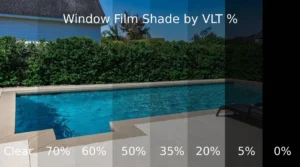Car window tinting is an excellent investment for improving comfort, privacy, and aesthetics while protecting your vehicle’s interior. However, with so many tint types available, it’s essential to understand the costs and benefits of each option to make an informed decision. In this guide, we’ll break down the costs of various car window tint and the factors that influence pricing, helping you find the best value for your needs.
Factors Affecting Car Window Tint Costs
Before diving into the specific types of window tints, let’s explore the factors that can influence the cost of installation:
1. Material Quality
Higher-quality materials, such as ceramic or nano-carbon films, are more expensive but offer superior performance and durability compared to basic dyed tints.
2. Vehicle Size and Type
Larger vehicles, such as SUVs or vans, require more material and labor, increasing the overall cost. Additionally, vehicles with complex window shapes may incur higher charges due to the precision needed for installation.
3. Number of Windows
Tinting all the windows of a vehicle costs more than just tinting the front or rear windows.
4. Local Regulations
California State laws and tinting laws regarding permissible tint levels can influence your options and, consequently, the cost. For example, legal limits on visible light transmission (VLT) percentages may require specialized films.
5. Installation Method
Professional installation ensures a flawless finish but comes at a higher price compared to DIY kits. However, professional services often include warranties, adding long-term value.
Types of Car Window Tints and Their Costs
1. Dyed Window Tint
Overview:
Dyed window tint is the most basic and affordable option. It uses a layer of dye to absorb sunlight, reducing heat and glare.
Benefits:
- Budget-friendly.
- Offers privacy with a dark appearance.
- Reduces glare and UV exposure.
Drawbacks:
- Less durable; prone to fading over time.
- Limited heat rejection compared to advanced options.
Cost:
- Average Price: $50 to $150 per vehicle (professional installation).
- Best For: Budget-conscious drivers seeking basic UV protection and privacy.
2. Metalized Window Tint
Overview:
Metalized tints incorporate metallic particles to reflect heat and sunlight, offering improved performance compared to dyed tints.
Benefits:
- Excellent heat rejection.
- Reduces glare effectively.
- Durable and fade-resistant.
Drawbacks:
- Can interfere with electronic signals (e.g., GPS, cell phones, and radios).
- Reflective appearance may not suit all aesthetic preferences.
Cost:
- Average Price: $100 to $300 per vehicle.
- Best For: Drivers prioritizing heat rejection and durability.
3. Carbon Window Tint
Overview:
Carbon tints use carbon particles to block infrared light, providing superior heat rejection without the reflectivity of metalized tints.
Benefits:
- Non-reflective, sleek matte finish.
- Excellent UV and heat protection.
- Long-lasting and fade-resistant.
Drawbacks:
- Slightly more expensive than dyed or metalized options.
Cost:
- Average Price: $150 to $400 per vehicle.
- Best For: Drivers seeking a balance between performance, aesthetics, and durability.
4. Ceramic Window Tint
Overview:
Ceramic tints represent the pinnacle of window tint technology, offering unparalleled performance and longevity.
Benefits:
- Blocks up to 99% of UV rays and significantly reduces heat.
- Does not interfere with electronic signals.
- Durable and resistant to fading or discoloration.
- Improves visibility by reducing glare without darkening the windows excessively.
Drawbacks:
- Higher upfront cost.
Cost:
- Average Price: $250 to $600 per vehicle.
- Best For: Drivers willing to invest in premium performance and comfort.
5. Hybrid Window Tint
Overview:
Hybrid tints combine dyed and metalized layers to offer a balance between affordability and performance.
Benefits:
- Effective heat rejection and UV protection.
- Less reflective than full metalized tints.
- Longer lifespan than dyed tints.
Drawbacks:
- Mid-range cost may not justify performance for all drivers.
Cost:
- Average Price: $150 to $350 per vehicle.
- Best For: Drivers seeking a middle-ground option with good performance at a moderate price.
Professional vs. DIY Installation
Professional Installation:
- Benefits:
- Ensures a flawless application with no bubbles or creases.
- Often includes warranties for materials and labor.
- Access to high-quality tints not available in DIY kits.
- Cost:
- Typically ranges from $100 to $600, depending on the tint type and vehicle size.
DIY Installation:
- Benefits:
- Significantly cheaper, with kits available for $20 to $100.
- Allows for flexibility and convenience.
- Drawbacks:
- Higher likelihood of imperfections like bubbles or peeling.
- No warranties or professional-grade materials.
Choosing the Right Tint for Your Needs
When selecting a window tint, consider:
- Budget: Set a realistic budget based on your priorities.
- Climate: In sunny areas like San Diego, ceramic or carbon tints may offer the best value.
- Aesthetic Preferences: Choose a tint that complements your vehicle’s style.
- Usage Needs: Evaluate whether you need advanced heat rejection or basic UV protection.
Conclusion
The cost of car window tint varies widely depending on the type of tint, vehicle size, and installation method. Understanding the differences between dyed, metalized, carbon, ceramic, and hybrid tints can help you make an informed decision that fits your budget and needs. For professional installation and expert guidance, contact a trusted local provider to ensure high-quality results and long-lasting performance.






